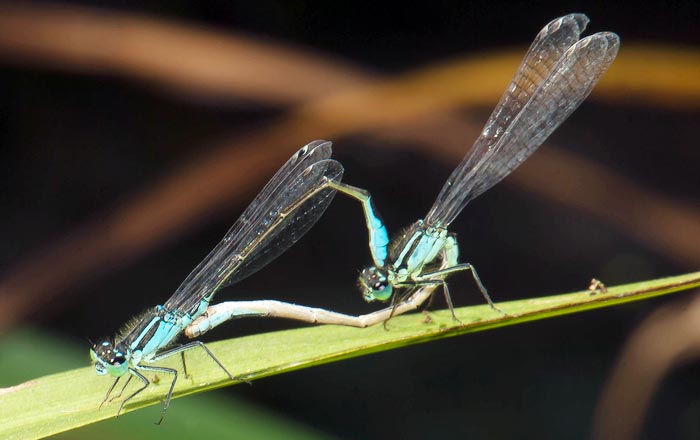Could one bacterium put damselflies in distress?

A pair of blue-tailed damselflies (Ischnura elegans)
Credit: Erik Svensson
Many insect species are currently expanding their geographical ranges in response to climate change. In the northern hemisphere, most of these species are moving northward, to escape the warming climate in the south.
New habitat colonisation occurs first with only a few establishing individuals. Consequently, the new populations are usually genetically poorer than the more central populations.
Other factors can also lead to genetic diversity loss. One of these may be the spread of the symbiotic bacterium Wolbachia in the quite common blue-tailed damselfly Ischnura elegans.
Wolbachia is a common endosymbiotic bacterium in insects, and it is naturally present in more than 40 per cent of all insect species across the globe. Wolbachia is highly prevalent in the damselfly populations in Western Europe and Fennoscandia, but less common in East Europe and the Mediterranean.
“Blue-tailed damselfly has been the study system of over 6,000 scientific studies, but until now, no one had ever investigated whether the species was hosting endosymbiotic bacteria. This is important to study because if the symbionts remain hidden in this system, research studies could be associating some results directly to the host ecology or evolutionary biology, when they are actually linked to the bacterium and only indirectly to the host,” says study author Junchen Deng, MSc, now doing his PhD at the Jagiellonian University in Krakow, Poland.
In a new study, the researchers used genetic markers to show that the Ischnura elegans populations carrying Wolbachia were genetically less diverse than the uninfected populations.
“In addition, the more central populations had reduced genetic diversity, not just the populations at the edge of the species’ range,” explains Dr Anne Duplouy, Academy Fellow at the Faculty of Biological and Environmental Sciences, University of Helsinki. She also supervised Junchen Deng’s master’s thesis at Lund University, Sweden.
A Wolbachia infection is often beneficial to infected insect females and can lead the Wolbachia-free host lineages to extinction.
“The goal of a symbiont is extremely selfish: it has to spread in its host population. Microbial symbionts have thus evolved a huge diversity of phenotypes to improve their spread in the host populations. For example, they can kill the brothers to release food resources to their sisters, they can make infected males incompatible with uninfected females but compatible with infected females, they can change males into females, they can improve the resistance of infected females against pathogens such as viruses, and so on,” Anne Duplouy describes.
As to damselflies and Wolbachia, there is much that is yet unknown.
“We still have no clear idea of how the bacterium manipulates the infected damselflies to its own benefit. But maybe, more importantly, this study shows how the bacterium could tamper with the success of its host in escaping and surviving a changing environment,” Erik Svensson, professor in evolutionary biology at Lund University points out.
“Indeed, if the source population is already low in genetic diversity, for example due to a hidden factor such as an infection with Wolbachia, the success of new colonisation might be reduced. With that comes a reduced ability of the host species to expand their range and escape climate change in their native habitats,” concludes Anne Duplouy.
Journal: BMC Ecology and Evolution
DOI: 10.1186/s12862-021-01906-6
Article Title: Wolbachia-driven selective sweep in a range expanding insect species
Article Publication Date: 25-Sep-2021
All latest news from the category: Life Sciences and Chemistry
Articles and reports from the Life Sciences and chemistry area deal with applied and basic research into modern biology, chemistry and human medicine.
Valuable information can be found on a range of life sciences fields including bacteriology, biochemistry, bionics, bioinformatics, biophysics, biotechnology, genetics, geobotany, human biology, marine biology, microbiology, molecular biology, cellular biology, zoology, bioinorganic chemistry, microchemistry and environmental chemistry.
Newest articles

Properties of new materials for microchips
… can now be measured well. Reseachers of Delft University of Technology demonstrated measuring performance properties of ultrathin silicon membranes. Making ever smaller and more powerful chips requires new ultrathin…

Floating solar’s potential
… to support sustainable development by addressing climate, water, and energy goals holistically. A new study published this week in Nature Energy raises the potential for floating solar photovoltaics (FPV)…

Skyrmions move at record speeds
… a step towards the computing of the future. An international research team led by scientists from the CNRS1 has discovered that the magnetic nanobubbles2 known as skyrmions can be…





















